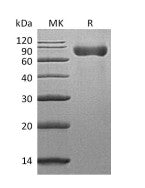1
/
of
2
Recombinant Mouse SLAMF3 (C-6His)
Recombinant Mouse SLAMF3 (C-6His)
Recombinant Mouse T-lymphocyte Surface Antigen Ly-9 is produced by our Mammalian expression system and the target gene encoding Lys48-Phe454 is expressed with a 6His tag at the C-terminus.
Catalog No:
EPT151
Regular price
$610.00 USD
Regular price
$469.00 USD
Sale price
$610.00 USD
Unit price
/
per
Couldn't load pickup availability
Product Details
Accession
Q4VBG4
Molecular Weight
47 KDa
Apparent Molecular Weight
65-75 KDa, reducing conditions
Purity
Greater than 95% as determined by reducing SDS-PAGE.
Endotoxin
Less than 0.1 ng/µg (1 EU/µg) as determined by LAL test.
Expression Host
Mammalian
Reconstitution
Always centrifuge tubes before opening.Do not mix by vortex or pipetting.
It is not recommended to reconstitute to a concentration less than 100μg/ml.
Dissolve the lyophilized protein in distilled water.
Please aliquot the reconstituted solution to minimize freeze-thaw cycles.
Shipping Condition
The product is shipped at ambient temperature. Upon receipt, store it immediately at the temperature listed in the Storage field.
Storage Condition and Shelf Life
Lyophilized protein should be stored at < -20C, though stable at room temperature for 3 weeks.
Reconstituted protein solution can be stored at 4-7°C for 2-7 days.
Aliquots of reconstituted samples are stable at < -20C for 3 months.
Background
CD229(SLAMF3) is a type I transmembrane glycoprotein in the SLAM subgroup of the CD2 family. Mature mouse CD229 consists of a 406 aa extracellular domain (ECD) with two Ig-like V-set and two Ig-like truncated C2-set domains, a 21 aa transmembrane segment, and a 180 aa cytoplasmic domain with two immunoreceptor tyrosinebased switch motifs ITSMs. Within the first two Ig-like domains that are common to all SLAM proteins, mouse CD229 shares 22%-36% aa sequence identity with mouse 2B4, BLAME, CD2F10,CD84, CRACC, NTBA, and SLAM. CD229 is expressed on T, B, and NK cells, thymocytes and monocytes. Homophilic binding between CD229 molecules is mediated by the N-terminal Ig-like domain. Human and mouse CD229 exhibit crossspecies binding. Antigen stimulation of lymphocytes induces CD229 clustering to sites of T cell-B cell contact. Antibody ligation of CD229 can inhibit T cell activation, but CD229 knockout mice show impaired T cell immune responses, suggesting a potential role for CD229 in T cell activation or costimulation.
Analyte
SLAMF3
Regulatory Status
For Research Use Only



